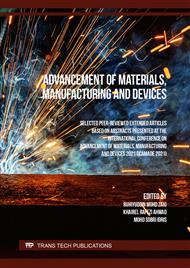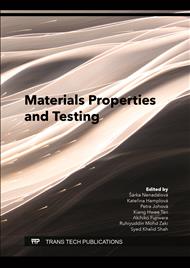[1]
F.C. Campbell, Elements of Metallurgy and Engineering Alloys. Ohio, ASM International, (2008).
Google Scholar
[2]
I.A. Sustaita-Torres, S.H. Rodríguez, M.P. Guerrero-Mata, M. Garza, E. Valdés, F. Deschaux-Beaume, R. Colás, Aging of a Cast 35Cr–45Ni Heat Resistant Alloy, Mater. Chem. & Physics 133 (2-3) (2012) 1018–1023.
DOI: 10.1016/j.matchemphys.2012.02.010
Google Scholar
[3]
S. Borjali, R. Saeed, Allahkaram, K. Hamed, Effects of Working Temperature and Carbon Diffusion on the Microstructure of High Pressure Heat-Resistant Stainless Steel Tubes Used in Pyrolysis Furnaces during Service Condition, Mater. & Des. 34 (2012) 65–73.
DOI: 10.1016/j.matdes.2011.07.069
Google Scholar
[4]
B. Piekarski, The Influence of Nb, Ti, and Si Additions on the Liquidus and Solidus Temperatures and Primary Microstructure Refinement in 0.3C-30Ni-18Cr Cast Steel, Mater. Charac. 61 (9) (2010) 899–906.
DOI: 10.1016/j.matchar.2010.06.001
Google Scholar
[5]
Y.X. Xu, J.T. Lu, W.Y. Li, X.W. Yang, Oxidation behaviour of Nb-rich Ni-Cr-Fe alloys: Role and effect of carbides precipitates, Cor. Sci. 140 (2018) 252-259.
DOI: 10.1016/j.corsci.2018.05.040
Google Scholar
[6]
Y.X. Xu, J.T. Lu, X.W. Yang, J.B. Yan, W.Y. Li, Effect and role of alloyed Nb on the air oxidation behaviour of Ni-Cr-Fe alloys at 1000°C, Cor. Sci. 127 (2017) 10-20.
DOI: 10.1016/j.corsci.2017.08.003
Google Scholar
[7]
L. Tan, X. Ren, K. Sridharan, T.R. Allen, Effect of Shot-Peening on the Oxidation of Alloy 800H Exposed to Supercritical Water and Cyclic Oxidation, Cor. Sci. 50 (7) (2008) 2040–(2046).
DOI: 10.1016/j.corsci.2008.04.008
Google Scholar
[8]
A. Munitz, S. Salhov, G. Guttmann, N. Derimow, M. Nahmany, Heat treatment influence on the microstructure and mechanical properties of AlCrFeNiTi0.5 high entropy alloys, Mater. Sci. & Eng. A 742 (2019) 1-14.
DOI: 10.1016/j.msea.2018.10.114
Google Scholar
[9]
X. Wang, J.A. Szpunar, Effects of grains sizes on the oxidation behavior of Ni-based alloy 230 and N, J. of Alloys & Comp. 752 (2018) 40-52.
DOI: 10.1016/j.jallcom.2018.04.173
Google Scholar
[10]
A. Munitz, L. Meshi, M.J. Kaufman, Heat treatments' effects on the microstructure and mechanical properties of an equiatomic Al-Cr-Fe-Mn-Ni high entropy alloy, Mater. Sci. & Eng. A 689 (2017) 384-394.
DOI: 10.1016/j.msea.2017.02.072
Google Scholar
[11]
N. Parimin, E. Hamzah, Role of alloyed niobium on the isothermal oxidation of Fe-40Ni-24Cr alloy, Mat. Sci. Forum 1010 (2020) 79-85.
DOI: 10.4028/www.scientific.net/msf.1010.79
Google Scholar
[12]
T.D. Nguyen, J. Zhang, D.J. young, Effect of Man on oxide formation by Fe-Cr and Fe-Cr-Ni alloys in dry and wet CO2 gases at 650°C, Cor. Sci. 112 (2016) 110-127.
DOI: 10.1016/j.corsci.2016.07.014
Google Scholar



